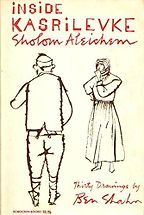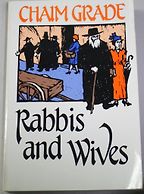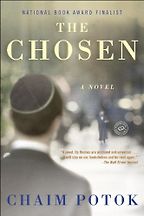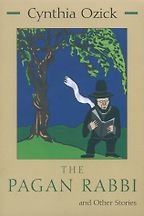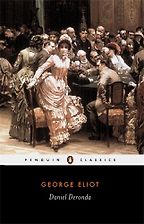When you were just starting out as a writer you were praised as the “young Mozart of Jewish fiction”. What is Jewish fiction?
There are many definitions. Some people would define it as writing by Jewish people, others as writing about Jewish subjects or the Jewish community or the Jewish religion. I tend to go for the second definition. I think of Jewish fiction as something that in some ways touches upon the Jewish experience.
Do you think of your writing as Jewish?
Sure. I think of it as Jewish because I deal with those themes, but I don’t think of it as only Jewish. I’m a Jewish writer; I’m also an American writer, a woman writer and a writer of English.
Let’s turn to the fiction itself, beginning with Sholem Aleichem. He is most widely known for writing the stories Tevye The Dairyman, which were made into the musical and film Fiddler on the Roof. You picked Inside Kasrilevke.
Sholem Aleichem is one of the greatest Yiddish authors. What stands out about his work is its humour and its poignancy. Fiddler on the Roof is the cartoon version of his work. The Kasrilevke stories are – as I recall from listening to my father read them aloud in English translation – very funny, laugh-out-loud funny. They are like comedy routines, building to high hilarity. The Kasrilevke tales are my comic ideal.
Sholem Aleichem is a pen name – a Yiddish version of the Hebrew phrase for “peace be with you”. He began writing in Russian and Hebrew but composed most of his work in Yiddish, and was an advocate of the language. What is Yiddish and how important is it to the development of Jewish fiction?
Yiddish, as I understand it, is a cross between Hebrew and German. It’s an amazing language, from a culture that is rich in literature, journalism and debate. My great grandmother spoke Yiddish. Until the end of her life, she read Yiddish newspapers and was very sorry that I didn’t learn the language. But Yiddish was the language of the old world, which those of us who were born in America didn’t have access to.
Let’s talk about another leading Yiddish writer of the 20th century, Chaim Grade. Please tell us about Rabbis and Wives.
These three novellas, set before the Holocaust, dramatise relationships between rabbis and wives, exploring the complex politics of family and community. The [English] translation first appeared when I was in high school, and I read an excerpt of this subtle and acutely insightful work in Commentary magazine. What really impressed me about his work was the understated way in which he painted a picture of a community and a culture that has been lost.
Some associate Jewish fiction with the broad humour found in the work of Sholem Aleichem. How is Grade’s work different?
Both Sholem Aleichem and Chaim Grade wrote in Yiddish. They wrote about this lost world, they were both very unsentimental and I admire that about them. But Grade showed me another kind of Jewish writing – slower, more formal and more analytic in its character studies. He’s a very restrained, understated writer, not funny in the way that Sholem Aleichem is. He’s much more sober.
Scholars estimate that on the eve of World War II there were 10 to 11 million Yiddish speakers in the world, but five million were killed during the war. Currently there are about 180,000 Yiddish speakers in the US and 30,000 in the UK. Yet there is an extraordinarily strong literary tradition relative to the size of the Yiddish-speaking population. Is there something intrinsic in the language that helped to give birth to such a robust literature?
My grandmother used to say that Yiddish was very rich in its humour and its sayings. I cannot speak to that directly myself because I’m not a Yiddish speaker or a Yiddish reader. If you are interested in knowing more, I would point you to the Yiddish Book Center in Amherst, Massachusetts. It’s an amazing repository of literature written in Yiddish, saved from destruction by its director Aaron Lansky.
Onward to a bestselling 1967 novel, The Chosen by Chaim Potok, written in English and set in America.
He wrote in a very mainstream way. As you say, the book was a bestseller and it was made into a beautiful movie. It is the first Jewish American book that really deals with religious people. His work stands out, in that way, from the work of novelists like Philip Roth and Saul Bellow – wonderful writers who were more culturally than religiously Jewish in their themes. Chaim Potok’s Judaism is not one of Woody Allen humour, it’s not the nostalgic old-world kind of stuff – it’s quite different. He tried to write about Jewish spirituality in America. He took religious people seriously. He wasn’t making fun of them and he wasn’t apologising for them. Rather, he took the reader into this world of Jewish believers.
Get the weekly Five Books newsletter
I read this book when I was 12. It was the first Jewish American novel I’d read that centred on religious characters – a rabbi, his brilliant son and the son’s best friend. I was fascinated by the novel’s dramatisation of religious experience in prayer and in Jewish learning. At the same time I found the book sentimental. I remember telling my mother that if I wrote a novel about a rabbi and his son they wouldn’t have a deathbed reconciliation. My mother was a little sceptical. But I ended up doing just that. In Kaaterskill Falls I had a rabbi and his son who were bitterly at odds. The rabbi is on his deathbed and the son comes to him. But the rabbi can’t forgive his son. Their differences are insurmountable. In many ways my novel was a response to The Chosen. I was interested in why somebody wouldn’t forgive.
Since Potok was a rabbi and the plot involves religion, it seems an opportune moment to ask how, if at all, do the tenets, texts and traditions of Judaism shape the work of Jewish writers?
Again, it varies by person. Jewish writers are such a diverse group. But I think it has changed in some ways – from older to younger generations. The older generation of Jewish American writers were satirists, social critics and quite American. The younger Jewish American writers – like me, or like Nathan Englander – write in a way that is very much informed by Jewish texts, and we weave in Jewish liturgy and Jewish rituals.
How does your religion affect your work?
In my case, it’s partly that I grew up in a more traditional household than some of the older writers, and it’s partly that I grew up in Honolulu – far from the American centres of Jewish culture that so many older writers were a part of. So in my early work, the religious dimension of Judaism was more important than the cultural dimension.
Next, let’s talk about Cynthia Ozick. Please tell me about her 1971 collection The Pagan Rabbi and Other Stories.
I have admired Cynthia Ozick since I was young. My father introduced me to her work in the pages of The New Yorker while I was in high school. I immediately responded to her intensity and delicacy, the layered beauty of her descriptions and her extraordinary vision of Jewish history and anxiety. I was fascinated by its richness sentence by sentence, by her use of metaphor, by her learning and the way that she embraced and celebrated Jewish texts and literary texts, the way she interwove strands of tradition.
You’ve said that Ozick was a role model. How did she inspire your work?
These stories inspired me in my own early work writing short fiction. She embraced Judaism, but also wrote as a citizen of the world. She has said herself, “In my fiction I’m free, I can be a man, a woman, I can be anyone.” I should also say that as a young writer I wrote to her, and she wrote back and encouraged me when I was only about 17. So in an incredibly generous way she responded to my work and to my earliest published stories, which is very rare among writers.
Ozick and Potok were first-generation Americans. Aleichem and Grade fled persecution and settled in America. How is 20th century Jewish literature shaped by the fact that many of its most admired writers are immigrants or the children of immigrants?
There’s a wonderful strand of immigrant literature within the tradition but as history moves on it changes, and literature reflects that experience. Mine does, and our children’s generation’s literature will look different from ours too.
Your last choice is George Eliot’s Daniel Deronda. Last I checked, George Eliot was a pseudonym for a 19th century woman baptised as Mary Anne Evans. Please explain your choice of Eliot and her last novel.
I consider Daniel Deronda a fine piece of Jewish literature, under my definition that it doesn’t have to be by a Jewish person as long as they write about the Jewish experience in a profound way. In this book, Eliot confronted anti-Semitism and the Jewish question in a way that her peers were not, either in literature or in their lives. It is about a Victorian gentleman who did not realise that he was Jewish but in the course of the novel he discovers the circumstances of his birth. It’s a book about identity, culture, religion and nationalism.
Eliot had it all – artistry, intellect, curiosity. She illuminated her characters from within, showing the reader their hearts and minds. She created a whole world in her fiction, enveloping the reader. All this and she seemed to invent Zionism on her own, years before the first Zionist Congress.
Eliot is a great writer for many reasons, but what impressed me most was her imaginative sympathy. She chose Jews and the Jewish question as the frame for an exploration of identity. Her commitment as an artist involved research and investigation. She did a huge amount of research. She visited synagogues to see what the service was like. She talked to Jewish people, she looked at Jewish texts, she read Spinoza, she even studied Hebrew. This book is a brilliant work of Jewish literature and also an extraordinary work of exploration. She’s an investigative writer, a researcher, and a wonderful example of somebody who didn’t stick to the old dictum “write what you know”.
Daniel Deronda, which I read when I was about 17, was tremendously important to me because it made me think I can write about the Jewish experience, but also that I can write about anything I can research. So it inspired me doubly – in my work as a Jewish writer, and in my work on topics not strictly connected to Jewish themes. Eliot showed me that you should write about what you know but also about what you learn. I took this lesson to heart when I chose to write about scientists in Intuition and environmentalists, technocrats and rare-book dealers in The Cookbook Collector. Eliot is the great explorer of Victorian novelists, and I often think of her as I write.
Your early work, such as The Family Markowitz
and Kaaterskill Falls, revolved around Jewish family life. But as you say, the plots of your most recent novels Intuition and The Cookbook Collector weave their way through a science lab and the computer-tech world respectively. With the trauma of the pogroms, the Holocaust and the mass migration of Jews fading from memory, what do you see as the 21st century themes of Jewish writing?
Those things are indeed fading from memory. In terms of writing about the contemporary Jewish community, there are many rich strands to pick up. Writing about assimilation is very interesting. Talking about intermarriage or people who return to religious Judaism is interesting – why do some people feel compelled to go farther away and others feel inexorably drawn back to their roots? Themes of identity and the persistence of belief in the modern world are all tremendously rich themes for writers to explore. They’re not themes that are limited to the Jewish community, but there’s a lot of good material there.
Interview by Eve Gerber
November 3, 2011. Updated: April 25, 2022
Five Books aims to keep its book recommendations and interviews up to date. If you are the interviewee and would like to update your choice of books (or even just what you say about them) please email us at [email protected]
Five Books interviews are expensive to produce. If you've enjoyed this interview, please support us by donating a small amount.
